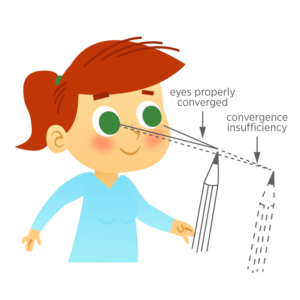This is a compelling case study conducted by our in-practice vision therapist, Dr. Zahra Tajbakhsh. To prioritise confidentiality, we have altered the patient’s name.
Presenting symptoms and initial evaluation
Introducing Corrine, a 12-year-old patient who presented to our practice with complaints of eyestrain, fatigue and discomfort during reading or close work. Additionally, she experienced headaches, drowsiness, and double vision when engaging in these activities. Corrine also reported difficulty moving her eyes, with her eye muscles feeling inflexible.

Upon her visit to our practice, we conducted a comprehensive binocular vision assessment on Corrine. Our findings revealed limited lateral eye movement, particularly in her right eye. Additionally, Corrine experienced pain in her eyes when looking upward.
 Convergence insufficiency detected
Convergence insufficiency detected
We did a convergence insufficiency symptom survey. Convergence insufficiency (CI) is a common near vision condition that impacts the ability to read, learn, and work at near distances. With CI, one eye tends to drift outward or away from the target when reading or performing other near vision activities. Children with CI often experience blurry or double vision, eye strain, and headaches when reading, using a computer, or performing other near vision activities for an extended period of time. This condition tends to manifest or worsen as the demands in school increase for reading and homework assignments.
Corrine’s convergence insufficiency symptom survey indicated the presence of convergence insufficiency and eye movement insufficiency, with a high score of 34, indicative of a significant frequency of symptoms. These issues were identified as the underlying cause of her symptoms and eye strain.
Eyecare Kids’ treatment plan
We initiated a 10-session vision therapy program spanning over 3 months.
 Vision therapy is a specialised form of therapy that aims to improve a person’s visual skills and abilities. It involves a series of individualised exercises and activities prescribed by a vision therapist to address specific visual problems such as crossed or lazy eye, poor eye coordination, and difficulty focusing.
Vision therapy is a specialised form of therapy that aims to improve a person’s visual skills and abilities. It involves a series of individualised exercises and activities prescribed by a vision therapist to address specific visual problems such as crossed or lazy eye, poor eye coordination, and difficulty focusing.
During vision therapy sessions, we use various tools and exercises to train the visual system. The therapy sessions include eye exercises, visual-motor integration tasks, vision games, and may involve the use of specialised lenses or prisms. The duration and frequency of therapy depend on the individual’s needs. By working with a vision therapist, individuals can undergo a tailored treatment plan to enhance their visual abilities and overall quality of life.
Corrine attended regular clinic-based activities and diligently followed the prescribed home exercises, allocating 10 minutes daily, five days a week.
The results from our treatment plan
Remarkable progress was observed by the end of the tenth session, as her score dramatically decreased to 4, reflecting an impressive improvement in symptoms. Corrine expressed her satisfaction, emphasizing the noticeable positive changes in her eyesight and how effortless near work has become.
This case exemplifies the effectiveness of vision therapy in addressing convergence insufficiency and associated eye movement difficulties. The successful outcome achieved in Corrine’s case highlights the potential of vision therapy as a valuable treatment modality for similar visual impairments in pediatric patients.
Dr Zahra Tajbakhsh
Eyecare Kids Vision Therapist
